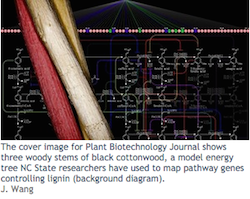According to Quanzi Li, the greatest barrier to producing biofuels is from stubborn plant cell walls that resist being broken down into biofuel ingredients. Li is the lead author of a paper published in Plant Biotechnology Journal about North Carolina (NC) State’s Forest Biotechnology Group biofuel research progress. Cell walls contain desirable cellulose and hemicellulose, which is “covered up” with lignin, the substance that contributes to the strength of wood but gets in the way of biofuel production.
In the case of wood, the lignin must be removed and then the resulting cellulose is converted to ethanol. Production begins with an expensive pretreatment, followed by enzyme use to release the sugars that can be fermented to produce ethanol. Li and her team are focusing on simplifying the process in various ways.
 NC State’s team has created genetically modified trees with reduced lignin content. “Normally when you reduce lignin, plant growth is negatively affected, which also reduces biomass production,” explained Li. “However, we now know that we can produce transgenic plants with strong cell walls and normal development but much less lignin.”
NC State’s team has created genetically modified trees with reduced lignin content. “Normally when you reduce lignin, plant growth is negatively affected, which also reduces biomass production,” explained Li. “However, we now know that we can produce transgenic plants with strong cell walls and normal development but much less lignin.”
Fast-growing trees with high energy content could grow on marginal land without disrupting crop production. NC State has worked extensively with black cottonwood (Populus trichocarpa). Forest Biotechnology Group researchers in the College of Natural Resources have developed engineering models that predict how 21 pathway enzymes affect lignin content and composition, providing the equivalent of GPS directions to guide future research.
This comprehensive approach, which involves genes, proteins, plant chemical compounds and mathematical models, fits into a systems biology perspective that’s the key to future breakthroughs, Li said. She added, “Progress has been made in many areas, but we still lack a complete understanding of how the cell wall is formed. We have to have a better idea of the factors that control its formation to produce better biomass for biofuels.”

